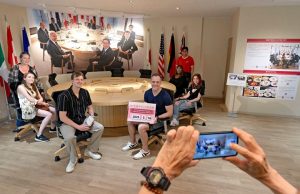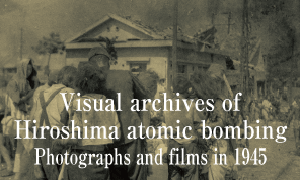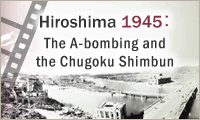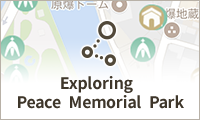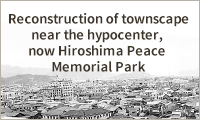Where we are now: Two years since Hiroshima Summit, Part 1: Hopes fade for world without nuclear weapons
May 20, 2025
by Koji Higuchi, Staff Writer
Two years have passed since the summit meeting of the G7 (Group of Seven industrialized nations) was held in Hiroshima City for the first time. During the period May 19–21, 2023, leaders of the world’s nuclear weapons states and other participating nations paid a visit to Peace Memorial Park in Hiroshima’s Naka Ward and made offerings of flowers at the Cenotaph for the A-bomb Victims. However, despite the growing number of visitors to the A-bombed city from throughout Japan and overseas, boosted by the city’s hosting of the G7 event, the international situation surrounding nuclear weapons now faces headwinds. Herein, the Chugoku Shimbun takes a look at the achievements of the Hiroshima Summit and the current challenges presented by the event.
Peace-government in partnership with citizens
On a weekday following an extended holiday period in May, tourists and children from Western countries looked carefully at the displays in the G7 Hiroshima Summit Commemorative Gallery, located in Peace Memorial Park in Hiroshima’s Naka Ward. Capturing their attention was the replica of a guestbook in which the G7 leaders had written their thoughts after coming into contact with the devastation caused by the atomic bombing at the Hiroshima Peace Memorial Museum.
Then-U.S. President Joe Biden, leader of the nuclear superpower, wrote in the guestbook, “Together let us continue to make progress toward the day when we can finally and forever rid the world of nuclear weapons.” Similarly, French President Emmanuel Macron, leader of that nuclear weapons state, indicated that “our sole mission is to act for peace.”
Nadia Miszczanyn, 67, a visitor who was visiting the museum this day from the United Kingdom, another of the nuclear weapons states, wore a frown as she acknowledged the significance of world leaders having gathered in the A-bombed city. Ms. Miszczanyn said she wondered to what extent the conflicts around the world might spread and admitted she was truly worried that her son might someday be sent to battle.
Russia’s invasion of Ukraine began more than three years ago, and Israel’s attacks on the Palestinian-controlled Gaza Strip are ongoing. India and Pakistan, both nuclear weapons states, engaged in military conflict earlier this month. Indian Prime Minister Narendra Modi also took part in the extended session of the Hiroshima Summit and posted on social media showing how intently he had observed the special exhibits in the museum.
Then-Japan Prime Minister Fumio Kishida, who represented a local Hiroshima electoral district and served as chair of the G7 Summit meeting, spoke at a press conference marking the conclusion of the summit. “We must now reaffirm this fundamental statement, which concerns the survival of the human race: ‘We must not use nuclear weapons, we must not threaten with nuclear weapons,’” said Mr. Kishida.
A communique issued by the leaders at the conclusion of the summit included an expressed commitment to the goal of a “world without nuclear weapons.” And the Hiroshima Vision, a document regarding nuclear disarmament backed by the leaders, called for the continued reduction in nuclear arsenals. However, over the past two years since the summit meeting, no progress in nuclear disarmament has been evident. On the contrary, nuclear weapons states, along with nations like Japan that remain under the U.S. nuclear umbrella, have come to rely even more on nuclear deterrence, affirmed as a G7 security policy in the Hiroshima Vision.
At a press conference on May 14 this year, Hiroshima City Mayor Kazumi Matsui expressed disappointment with the current situation two years after the G7. “I can’t help but feel that we’re moving further away from the abolition of nuclear weapons,” said Mr. Matsui. Arguing that a cycle of mutual distrust among nuclear weapons states has hindered progress on nuclear disarmament, he added, “It’s necessary to take a step forward.”
It is not enough to simply complain. What does the Hiroshima City government need to do now? Hiroshi Harada, 85, is an A-bomb survivor living in the city’s Asaminami Ward who once served as director of the Hiroshima Peace Memorial Museum. In 1995, the 50th year after the atomic bombing, he devoted himself to a project called “Postcards to the 21st Century from Hiroshima,” in which citizens left messages to a time 50 years in the future. Based on his experience in collecting more than 90,000 such postcards, he asserted that what is now needed was “a peace government in partnership with citizens.”
Mr. Harada noted that the city government’s projects designed to commemorate the 80th anniversary of the A-bombing “appear mostly as one-time events without reference to the Hiroshima Summit.” He expressed hope that his former workplace of the city government “will now make serious efforts to build peace together with citizens, because A-bomb survivors are aging and have little time left.” Mr. Harada added that the diverse voices of citizens have the power to move government leaders around the world.
Keywords
Summit meeting of the G7 (Group of Seven industrialized nations)
During the period May 19–21, 2023, the summit meeting of the G7 (Group of Seven industrialized nations) was held at the Grand Prince Hotel Hiroshima, located in the city’s Minami Ward, the main venue of the gathering. It was the first time the G7 Summit had been held in the A-bombed city. Leaders of the seven nuclear weapons states, including the United States, the United Kingdom, and France, as well as the European Union (EU), took part in the meeting, with Prime Minister Fumio Kishida serving as chair. On the opening day, all the leaders visited Peace Memorial Park, touring the Hiroshima Peace Memorial Museum to view a portion of its A-bomb artifacts and meeting with an A-bomb survivor. The leaders made offerings of flowers at the Cenotaph for the A-bomb Victims and viewed the A-bomb Dome. That same day, they adopted the Hiroshima Vision, the first G7 accord devoted specifically to nuclear disarmament. On the final day, Ukrainian President Volodymyr Zelenskyy made a surprise appearance at the summit.
(Originally published on May 20, 2025)
Two years have passed since the summit meeting of the G7 (Group of Seven industrialized nations) was held in Hiroshima City for the first time. During the period May 19–21, 2023, leaders of the world’s nuclear weapons states and other participating nations paid a visit to Peace Memorial Park in Hiroshima’s Naka Ward and made offerings of flowers at the Cenotaph for the A-bomb Victims. However, despite the growing number of visitors to the A-bombed city from throughout Japan and overseas, boosted by the city’s hosting of the G7 event, the international situation surrounding nuclear weapons now faces headwinds. Herein, the Chugoku Shimbun takes a look at the achievements of the Hiroshima Summit and the current challenges presented by the event.
Greater dependence on nuclear deterrence
Peace-government in partnership with citizens
On a weekday following an extended holiday period in May, tourists and children from Western countries looked carefully at the displays in the G7 Hiroshima Summit Commemorative Gallery, located in Peace Memorial Park in Hiroshima’s Naka Ward. Capturing their attention was the replica of a guestbook in which the G7 leaders had written their thoughts after coming into contact with the devastation caused by the atomic bombing at the Hiroshima Peace Memorial Museum.
Then-U.S. President Joe Biden, leader of the nuclear superpower, wrote in the guestbook, “Together let us continue to make progress toward the day when we can finally and forever rid the world of nuclear weapons.” Similarly, French President Emmanuel Macron, leader of that nuclear weapons state, indicated that “our sole mission is to act for peace.”
Nadia Miszczanyn, 67, a visitor who was visiting the museum this day from the United Kingdom, another of the nuclear weapons states, wore a frown as she acknowledged the significance of world leaders having gathered in the A-bombed city. Ms. Miszczanyn said she wondered to what extent the conflicts around the world might spread and admitted she was truly worried that her son might someday be sent to battle.
Russia’s invasion of Ukraine began more than three years ago, and Israel’s attacks on the Palestinian-controlled Gaza Strip are ongoing. India and Pakistan, both nuclear weapons states, engaged in military conflict earlier this month. Indian Prime Minister Narendra Modi also took part in the extended session of the Hiroshima Summit and posted on social media showing how intently he had observed the special exhibits in the museum.
Then-Japan Prime Minister Fumio Kishida, who represented a local Hiroshima electoral district and served as chair of the G7 Summit meeting, spoke at a press conference marking the conclusion of the summit. “We must now reaffirm this fundamental statement, which concerns the survival of the human race: ‘We must not use nuclear weapons, we must not threaten with nuclear weapons,’” said Mr. Kishida.
A communique issued by the leaders at the conclusion of the summit included an expressed commitment to the goal of a “world without nuclear weapons.” And the Hiroshima Vision, a document regarding nuclear disarmament backed by the leaders, called for the continued reduction in nuclear arsenals. However, over the past two years since the summit meeting, no progress in nuclear disarmament has been evident. On the contrary, nuclear weapons states, along with nations like Japan that remain under the U.S. nuclear umbrella, have come to rely even more on nuclear deterrence, affirmed as a G7 security policy in the Hiroshima Vision.
At a press conference on May 14 this year, Hiroshima City Mayor Kazumi Matsui expressed disappointment with the current situation two years after the G7. “I can’t help but feel that we’re moving further away from the abolition of nuclear weapons,” said Mr. Matsui. Arguing that a cycle of mutual distrust among nuclear weapons states has hindered progress on nuclear disarmament, he added, “It’s necessary to take a step forward.”
It is not enough to simply complain. What does the Hiroshima City government need to do now? Hiroshi Harada, 85, is an A-bomb survivor living in the city’s Asaminami Ward who once served as director of the Hiroshima Peace Memorial Museum. In 1995, the 50th year after the atomic bombing, he devoted himself to a project called “Postcards to the 21st Century from Hiroshima,” in which citizens left messages to a time 50 years in the future. Based on his experience in collecting more than 90,000 such postcards, he asserted that what is now needed was “a peace government in partnership with citizens.”
Mr. Harada noted that the city government’s projects designed to commemorate the 80th anniversary of the A-bombing “appear mostly as one-time events without reference to the Hiroshima Summit.” He expressed hope that his former workplace of the city government “will now make serious efforts to build peace together with citizens, because A-bomb survivors are aging and have little time left.” Mr. Harada added that the diverse voices of citizens have the power to move government leaders around the world.
Keywords
Summit meeting of the G7 (Group of Seven industrialized nations)
During the period May 19–21, 2023, the summit meeting of the G7 (Group of Seven industrialized nations) was held at the Grand Prince Hotel Hiroshima, located in the city’s Minami Ward, the main venue of the gathering. It was the first time the G7 Summit had been held in the A-bombed city. Leaders of the seven nuclear weapons states, including the United States, the United Kingdom, and France, as well as the European Union (EU), took part in the meeting, with Prime Minister Fumio Kishida serving as chair. On the opening day, all the leaders visited Peace Memorial Park, touring the Hiroshima Peace Memorial Museum to view a portion of its A-bomb artifacts and meeting with an A-bomb survivor. The leaders made offerings of flowers at the Cenotaph for the A-bomb Victims and viewed the A-bomb Dome. That same day, they adopted the Hiroshima Vision, the first G7 accord devoted specifically to nuclear disarmament. On the final day, Ukrainian President Volodymyr Zelenskyy made a surprise appearance at the summit.
(Originally published on May 20, 2025)

